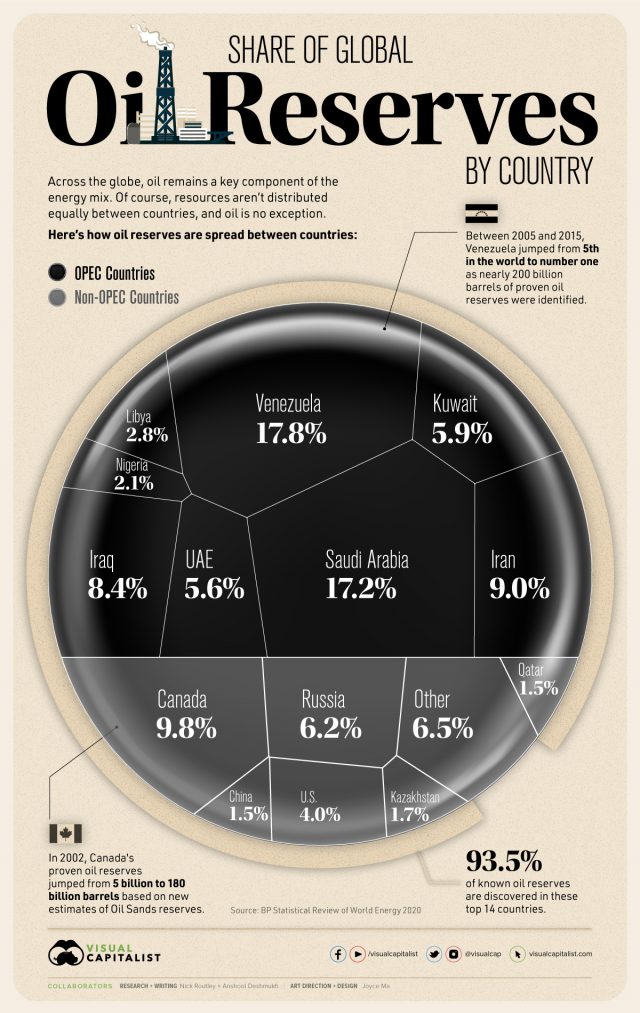| Rank |
Country |
Oil Reserves
(billion barrels) |
Share of Global Reserves |
| #1 |
🇻🇪 Venezuela |
304 |
17.8% |
| #2 |
🇸🇦 Saudi Arabia |
298 |
17.2% |
| #3 |
🇨🇦 Canada |
170 |
9.8% |
| #4 |
🇮🇷 Iran |
156 |
9.0% |
| #5 |
🇮🇶 Iraq |
145 |
8.4% |
| #6 |
🇷🇺 Russia |
107 |
6.2% |
| #7 |
🇰🇼 Kuwait |
102 |
5.9% |
| #8 |
🇦🇪 UAE |
98 |
5.6% |
| #9 |
🇺🇸 United States |
69 |
4.0% |
| #10 |
🇱🇾 Libya |
48 |
2.8% |
| #11 |
🇳🇬 Nigeria |
37 |
2.1% |
| #12 |
🇰🇿 Kazakhstan |
30 |
1.7% |
| #13 |
🇨🇳 China |
26.2 |
1.5% |
| #14 |
🇶🇦 Qatar |
25.2 |
1.5% |
While these countries are found all over the globe, a few countries have much larger amounts than others. Venezuela is the leading country in terms of oil reserves, with over 304 billion barrels of oil beneath its surface. Saudi Arabia is a close second with 298 billion, and Canada is third with 170 billion barrels of oil reserves.
Oil Reserves vs. Oil Production
A country with large amounts of reserves does not always translate to strong production numbers for petroleum, oil, and by-products. Oil reserves simply serve as an estimate of the amount of economically recoverable crude oil in a particular region. To qualify, these reserves must have the potential of being extracted under current technological constraints.
While countries like the U.S. and Russia are low on the list of oil reserves, they rank highly in terms of oil production. More than 95 million barrels of oil were produced globally every day in 2019, and the U.S., Saudi Arabia, and Russia are among the world’s top oil-producing countries, respectively.
Oil Sands Contributing to Growing Reserves
Venezuela has long been an oil-producing country with heavy economic reliance on oil exports. However, in 2011, Venezuela’s energy and oil ministry announced an unprecedented increase in proven oil reserves as oil sands in the Orinoco Belt territory were certified.
Between 2005 and 2015, Venezuela jumped from fifth in the world to number one as nearly 200 billion barrels of proven oil reserves were identified. As a result, South and Central America’s proven oil reserves more than doubled between 2008 and 2011.
In 2002, Canada’s proven oil reserves jumped from 5 billion to 180 billion barrels based on new oil sands estimates.
Canada accounts for almost 10% of the world’s proven oil reserves at 170 billion barrels, with an estimated 166.3 billion located in Alberta’s oil sands, and the rest found in conventional, offshore, and tight oil formations.
Large Reserves in OPEC Nations
The Organization of the Petroleum Exporting Countries (OPEC) is an intergovernmental global petroleum and oil distribution agency headquartered in Vienna, Austria.
The majority of countries with the largest oil reserves in the world are members of OPEC. Now composed of 14 member states, OPEC holds nearly 70% of crude oil reserves worldwide.
Most OPEC countries are in the Middle East, the region with the largest oil reserves, holding nearly half of the global share.
Regional Shifts
Though most of the proven oil reserves in the world were historically considered to be centered in the Middle East, in the past three decades their share of global oil reserves has dropped, from over 60% in 1992 to about 48% in 2019.
One of the main reasons for this drop was constant oil production and greater reserves discovered in the Americas. By 2012, Central and South America’s share had more than doubled and has remained just under 20% in the years since.
While oil sands ushered in a new era of global oil reserve domination, as the world shifts away from oil consumption and towards green energy and electrification, these reserves might not matter as much in the future as they once did.





